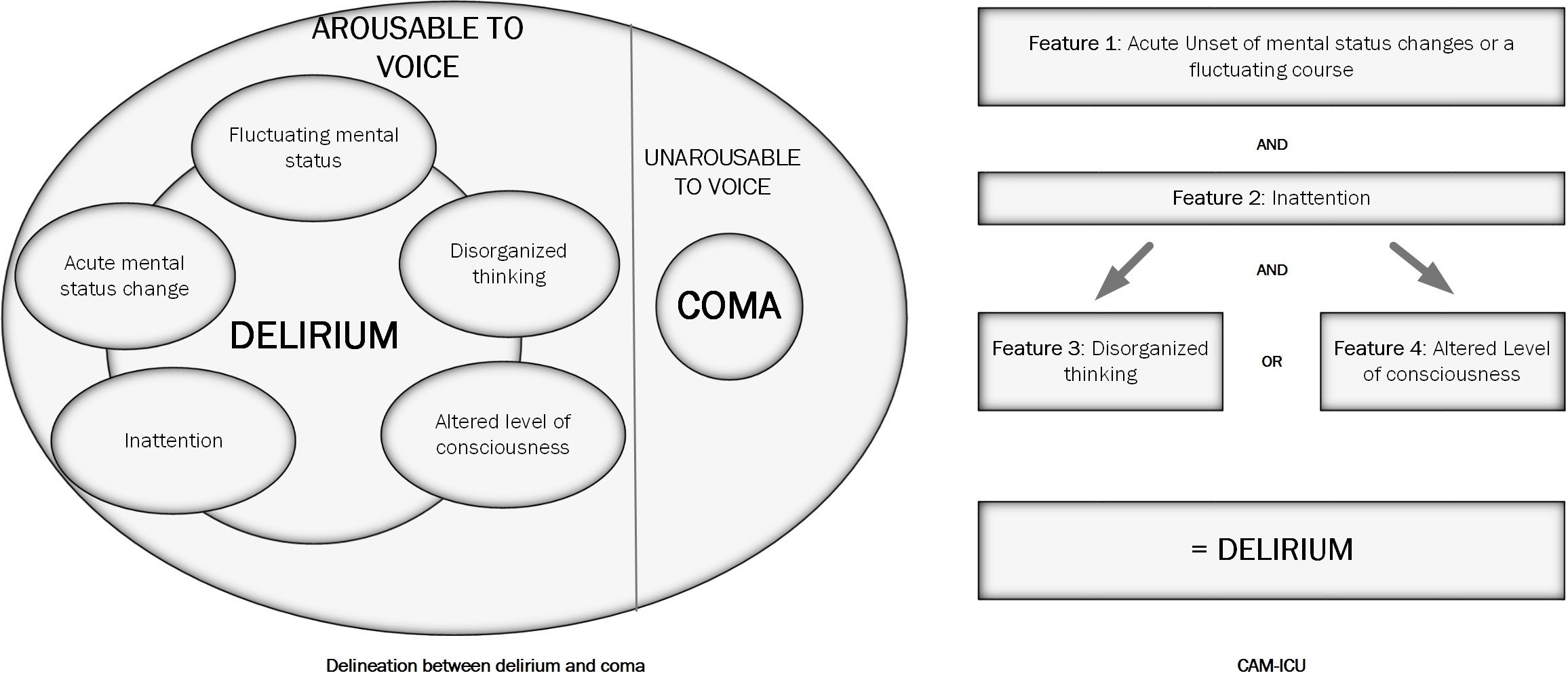[1]
Evered L,Silbert B,Knopman DS,Scott DA,DeKosky ST,Rasmussen LS,Oh ES,Crosby G,Berger M,Eckenhoff RG,Nomenclature Consensus Working Group., Recommendations for the Nomenclature of Cognitive Change Associated with Anaesthesia and Surgery-20181. Journal of Alzheimer's disease : JAD. 2018
[PubMed PMID: 30347621]
Level 3 (low-level) evidence
[3]
Vasilevskis EE,Han JH,Hughes CG,Ely EW, Epidemiology and risk factors for delirium across hospital settings. Best practice & research. Clinical anaesthesiology. 2012 Sep
[PubMed PMID: 23040281]
[4]
Moller JT,Cluitmans P,Rasmussen LS,Houx P,Rasmussen H,Canet J,Rabbitt P,Jolles J,Larsen K,Hanning CD,Langeron O,Johnson T,Lauven PM,Kristensen PA,Biedler A,van Beem H,Fraidakis O,Silverstein JH,Beneken JE,Gravenstein JS, Long-term postoperative cognitive dysfunction in the elderly ISPOCD1 study. ISPOCD investigators. International Study of Post-Operative Cognitive Dysfunction. Lancet (London, England). 1998 Mar 21
[PubMed PMID: 9525362]
[5]
Kowark A,Adam C,Ahrens J,Bajbouj M,Bollheimer C,Borowski M,Dodel R,Dolch M,Hachenberg T,Henzler D,Hildebrand F,Hilgers RD,Hoeft A,Isfort S,Kienbaum P,Knobe M,Knuefermann P,Kranke P,Laufenberg-Feldmann R,Nau C,Neuman MD,Olotu C,Rex C,Rossaint R,Sanders RD,Schmidt R,Schneider F,Siebert H,Skorning M,Spies C,Vicent O,Wappler F,Wirtz DC,Wittmann M,Zacharowski K,Zarbock A,Coburn M, Improve hip fracture outcome in the elderly patient (iHOPE): a study protocol for a pragmatic, multicentre randomised controlled trial to test the efficacy of spinal versus general anaesthesia. BMJ open. 2018 Oct 18
[PubMed PMID: 30341135]
Level 1 (high-level) evidence
[6]
Maldonado JR, Pathoetiological model of delirium: a comprehensive understanding of the neurobiology of delirium and an evidence-based approach to prevention and treatment. Critical care clinics. 2008 Oct
[PubMed PMID: 18929943]
Level 3 (low-level) evidence
[7]
Maldonado JR, Delirium in the acute care setting: characteristics, diagnosis and treatment. Critical care clinics. 2008 Oct
[PubMed PMID: 18929939]
[8]
Morandi A,Pandharipande P,Trabucchi M,Rozzini R,Mistraletti G,Trompeo AC,Gregoretti C,Gattinoni L,Ranieri MV,Brochard L,Annane D,Putensen C,Guenther U,Fuentes P,Tobar E,Anzueto AR,Esteban A,Skrobik Y,Salluh JI,Soares M,Granja C,Stubhaug A,de Rooij SE,Ely EW, Understanding international differences in terminology for delirium and other types of acute brain dysfunction in critically ill patients. Intensive care medicine. 2008 Oct
[PubMed PMID: 18563387]
Level 3 (low-level) evidence
[9]
Sessler CN,Gosnell MS,Grap MJ,Brophy GM,O'Neal PV,Keane KA,Tesoro EP,Elswick RK, The Richmond Agitation-Sedation Scale: validity and reliability in adult intensive care unit patients. American journal of respiratory and critical care medicine. 2002 Nov 15
[PubMed PMID: 12421743]
[10]
Chen CC,Li HC,Liang JT,Lai IR,Purnomo JDT,Yang YT,Lin BR,Huang J,Yang CY,Tien YW,Chen CN,Lin MT,Huang GH,Inouye SK, Effect of a Modified Hospital Elder Life Program on Delirium and Length of Hospital Stay in Patients Undergoing Abdominal Surgery: A Cluster Randomized Clinical Trial. JAMA surgery. 2017 Sep 1
[PubMed PMID: 28538964]
Level 1 (high-level) evidence
[11]
Hayhurst CJ,Pandharipande PP,Hughes CG, Intensive Care Unit Delirium: A Review of Diagnosis, Prevention, and Treatment. Anesthesiology. 2016 Dec
[PubMed PMID: 27748656]
[12]
Schaller SJ,Anstey M,Blobner M,Edrich T,Grabitz SD,Gradwohl-Matis I,Heim M,Houle T,Kurth T,Latronico N,Lee J,Meyer MJ,Peponis T,Talmor D,Velmahos GC,Waak K,Walz JM,Zafonte R,Eikermann M,International Early SOMS-guided Mobilization Research Initiative., Early, goal-directed mobilisation in the surgical intensive care unit: a randomised controlled trial. Lancet (London, England). 2016 Oct 1
[PubMed PMID: 27707496]
Level 1 (high-level) evidence
[13]
Reade MC,Eastwood GM,Bellomo R,Bailey M,Bersten A,Cheung B,Davies A,Delaney A,Ghosh A,van Haren F,Harley N,Knight D,McGuiness S,Mulder J,O'Donoghue S,Simpson N,Young P,DahLIA Investigators.,Australian and New Zealand Intensive Care Society Clinical Trials Group., Effect of Dexmedetomidine Added to Standard Care on Ventilator-Free Time in Patients With Agitated Delirium: A Randomized Clinical Trial. JAMA. 2016 Apr 12
[PubMed PMID: 26975647]
Level 1 (high-level) evidence
[14]
Carrasco G,Baeza N,Cabré L,Portillo E,Gimeno G,Manzanedo D,Calizaya M, Dexmedetomidine for the Treatment of Hyperactive Delirium Refractory to Haloperidol in Nonintubated ICU Patients: A Nonrandomized Controlled Trial. Critical care medicine. 2016 Jul
[PubMed PMID: 26925523]
Level 2 (mid-level) evidence
[15]
Djaiani G,Silverton N,Fedorko L,Carroll J,Styra R,Rao V,Katznelson R, Dexmedetomidine versus Propofol Sedation Reduces Delirium after Cardiac Surgery: A Randomized Controlled Trial. Anesthesiology. 2016 Feb
[PubMed PMID: 26575144]
Level 1 (high-level) evidence
[16]
Osiezagha K,Ali S,Freeman C,Barker NC,Jabeen S,Maitra S,Olagbemiro Y,Richie W,Bailey RK, Thiamine deficiency and delirium. Innovations in clinical neuroscience. 2013 Apr;
[PubMed PMID: 23696956]
[18]
Inouye SK,Marcantonio ER,Kosar CM,Tommet D,Schmitt EM,Travison TG,Saczynski JS,Ngo LH,Alsop DC,Jones RN, The short-term and long-term relationship between delirium and cognitive trajectory in older surgical patients. Alzheimer's & dementia : the journal of the Alzheimer's Association. 2016 Jul
[PubMed PMID: 27103261]
[19]
Neufeld KJ,Leoutsakos JM,Sieber FE,Wanamaker BL,Gibson Chambers JJ,Rao V,Schretlen DJ,Needham DM, Outcomes of early delirium diagnosis after general anesthesia in the elderly. Anesthesia and analgesia. 2013 Aug
[PubMed PMID: 23757476]
[20]
Hamilton GM,Wheeler K,Di Michele J,Lalu MM,McIsaac DI, A Systematic Review and Meta-analysis Examining the Impact of Incident Postoperative Delirium on Mortality. Anesthesiology. 2017 Jul
[PubMed PMID: 28459734]
Level 1 (high-level) evidence
[21]
Raats JW,van Eijsden WA,Crolla RM,Steyerberg EW,van der Laan L, Risk Factors and Outcomes for Postoperative Delirium after Major Surgery in Elderly Patients. PloS one. 2015
[PubMed PMID: 26291459]
[22]
Reston JT,Schoelles KM, In-facility delirium prevention programs as a patient safety strategy: a systematic review. Annals of internal medicine. 2013 Mar 5
[PubMed PMID: 23460093]
Level 1 (high-level) evidence
[23]
Inouye SK,Bogardus ST Jr,Baker DI,Leo-Summers L,Cooney LM Jr, The Hospital Elder Life Program: a model of care to prevent cognitive and functional decline in older hospitalized patients. Hospital Elder Life Program. Journal of the American Geriatrics Society. 2000 Dec
[PubMed PMID: 11129764]
[24]
Inouye SK,Baker DI,Fugal P,Bradley EH, Dissemination of the hospital elder life program: implementation, adaptation, and successes. Journal of the American Geriatrics Society. 2006 Oct
[PubMed PMID: 17038065]

